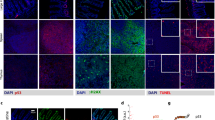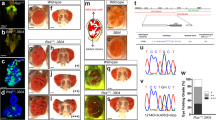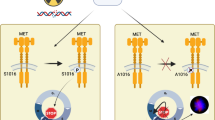Abstract
Exposure of MDA-MB-231 human mammary carcinoma cells to an ionizing radiation dose of 2 Gy results in immediate activation and Tyr phosphorylation of the epidermal growth factor receptor (EGFR). Doxycycline induced expression of a dominant negative EGFR-CD533 mutant, lacking the COOH-terminal 533 amino acids, in MDA-TR15-EGFR-CD533 cells was used to characterize intracellular signaling responses following irradiation. Within 10 min, radiation exposure caused an immediate, transient activation of mitogen activated protein kinase (MAPK) which was completely blocked by expression of EGFR-CD533. The same radiation treatment also induced an immediate activation of the c-Jun-NH2-terminal kinase 1 (JNK1) pathway that was followed by an extended rise in kinase activity after 30 min. Expression of EGFR-CD533 did not block the immediate JNK1 response but completely inhibited the later activation. Treatment of MDA-TR15-EGFR-CD533 cells with the MEK1/2 inhibitor, PD98059, resulted in ∼70% inhibition of radiation-induced MAPK activity, and potentiated the radiation-induced increase of immediate JNK1 activation twofold. Inhibition of Ras farnesylation with a concomitant inhibition of Ras function completely blocked radiation-induced MAPK and JNK1 activation. Modulation of EGFR and MAPK functions also altered overall cellular responses of growth and apoptosis. Induction of EGFR-CD533 or treatment with PD98059 caused a 3 – 5-fold increase in radiation toxicity in a novel repeated radiation exposure growth assay by interfering with cell proliferation and potentiating apoptosis. In summary, this data demonstrates that both MAPK and JNK1 activation in response to radiation occur through EGFR-dependent and -independent mechanisms, and are mediated by signaling through Ras. Furthermore, we have demonstrated that radiation-induced activation of EGFR results in downstream activation of MAPK which may affect the radiosensitivity of carcinoma cells.
This is a preview of subscription content, access via your institution
Access options
Subscribe to this journal
Receive 50 print issues and online access
$259.00 per year
only $5.18 per issue
Buy this article
- Purchase on Springer Link
- Instant access to full article PDF
Prices may be subject to local taxes which are calculated during checkout







Similar content being viewed by others
Abbreviations
- EGFR:
-
epidermal growth factor receptor
- EGFR-CD533:
-
dominant negative EGFR
- MAP kinase:
-
mitogen-activated protein kinase
- JNK1:
-
c-Jun NH2-terminal kinase
- Ionizing:
-
radiation
References
Antonyak MA, Moscatello DK and Wong AJ. . 1998 J. Biol. Chem. 273: 2817–2822.
Auer K, Contessa J, Brenz-Verca S, Pirola L, Rusconi S, Cooper G, Abo A, Wymann M, Davis RJ, Birrer M and Dent P. . 1998 Mol. Biol. Cell 9: 561–573.
Balaban N, Moni J, Shannon M, Dang L, Murphy E and Goldkorn T. . 1996 Biochim. Biophys. Acta 1314: 147–156.
Bentzen SM and Thames HD. . 1991 Radiother. Oncol. 22: 161–166.
Boulton TG, Yancopoulos GD, Gregory JS, Slaughter C, Moomaw C, Hsu J and Cobb MH. . 1990 Science 249: 64–67.
Brown PH, Alani R, Preis LH, Szabo E and Birrer MJ. . 1993 Oncogene 8: 877–886.
Brown PH, Kim SH, Wise SC, Sabichi AL and Birrer MJ. . 1996 Cell Growth Differ. 8: 1013–1021.
Cai H, Smola U, Wixler V, Eisenmann-Tappe I, Diaz-Meco MT, Moscat J, Rapp U and Cooper G. . 1997 Mol. Cell. Biol. 17: 732–741.
Carmichael J, DeGraff WG, Gazdar AF, Minna JD and Mitchell JB. . 1987 Cancer Res. 47: 943–946.
Carter S, Auer KL, Reardon DB, Birrer M, Fisher PB, Schmidt-Ullrich RK, Valerie K, Mikkelsen R and Dent P. . 1998 Oncogene 16: 2787–2796.
Chelliah J, Freemerman AJ, Wu-Pong S, Jarvis WD and Grant S. . 1997 Biochem. Pharmacol. 54: 563–573.
Chen D, Waters SB, Holt KH and Pessin JE. . 1996a J. Biol. Chem. 271: 6328–6332.
Chen TK, Smith LM, Gebhardt DK, Birrer MJ and Brown PH. . 1996b Mol. Carcinog. 3: 215–226.
Chen YR, Wang W, Kong AN and Tan TH. . 1998 J. Biol. Chem. 273: 69–1775.
Chmura SJ, Nodzenski E, Beckett MA, Kufe DW, Quintans J and Weichselbaum RR. . 1997 Cancer Res. 57: 1270–1275.
Contessa JN, Reardon DB, Todd D, Dent P, Mikkelsen RB, Valerie K, Bowers GD and Schmidt-Ullrich RK . 1999 Clin. Cancer. Res. 5: 405–411.
Denizot F and Lang R. . 1986 J. Immunol. Methods 89: 271–277.
Dewey WC, Ling CC and Meyn RE. . 1995 Int. J. Radiat. Oncol. Biol. Phys. 33: 781–796.
Derijard B, Hibi M, Wu IH, Barrett T, Su B, Deng T, Karin M and Davis RJ. . 1994 Cell 76: 1025–1037.
Douville E and Downward J. . 1997 Oncogene 15: 373–383.
Dudley DT, Pang L, Decker SJ, Bridges AJ and Saltiel AR. . 1995 Proc. Natl. Acad. Sci. USA 92: 7686–7689.
Goldkorn T, Balaban N, Shannon M and Matsukuma K. . 1997 Biochim. Biophys. Acta 1358: 289–299.
Gorczyca W, Gong J and Darzynkiewicz Z. . 1993 Cancer Res. 53: 1945–1951.
Gossen M, Freundlieb S, Bender G, Mueller G, Hillen W and Bujard H. . 1995 Science 268: 1766–1769.
Gupta AK, Lee YJ, Galoforo SS, Berns CM, Martinez AA, Corry PM, Wu XY and Guan KL. . 1997 Mol. Cell. Biochem. 170: 23–30.
Guo YL, Baysal K, Kang B, Yang LJ and Williamson JR. . 1998 J. Biol. Chem. 273: 4027–4034.
Haimovitz-Friedman A, Kan CC, Ehleiter D, Persaud RS, McLoughlin M, Fuks Z and Kolsenik R. . 1994 J. Exp. Med. 180: 525–535.
Heerdt BG, Houston MA and Augenlicht LH. . 1994 Cancer Res. 54: 3288–3294.
Holt KH, Waters SB, Okada S, Yamauchi K, Decker SJ, Saltiel AR, Motto DG, Koretzky GA and Pessin JE. . 1996 J. Biol. Chem. 271: 8300–8306.
Huang C, Ma W, Ding M, Bowden GT and Dong Z. . 1997 J. Biol. Chem. 272: 27753–27757.
Janulis M, Silberman S, Ambegaokar A, Gutkind JS and Schultz RM. . 1999 J. Biol. Chem. 274: 801–813.
Jarvis WD, Auer KL, Spector M, Kunos G, Grant G and Dent P. . 1997a FEBS Lett. 412: 9–14.
Jarvis WD, Fornari FA, Auer KL, Freemerman AJ, Szabo E, Birrer MJ, Barbour SE, Dent P and Grant S. . 1997b Mol. Pharm. 2: 935–947.
Jarvis WD, Fornari FA, Traylor RS, Martin HA, Kramer LB, Erukulla RK, Bittman R and Grant S. . 1996 J. Biol. Chem. 271: 8275–8284.
Kashles O, Yarden Y, Fischer R, Ullrich A and Schlessinger J. . 1991 Mol. Cell. Biol. 11: 1454–1463.
Kasid U, Suy S, Dent P, Whitside T and Sturgill TW. . 1996 Nature 382: 316–318.
Kavanagh BD, Dent P, Chen P, Schmidt-Ullrich RK and Mikkelsen RB. . 1998 Radiation Res. 149: 579–587.
Kavanagh BD, Lin P-S, Chen P and Schmidt-Ullrich RK. . 1995 Clin. Cancer Res. 1: 1557–1562.
Kawasaki H, Moriguchi T, Matsuda S, Li HZ, Nakamura S, Shimohama S, Kimura J, Gotoh Y and Nishida E. . 1996 Eur. J. Biochem. 241: 315–321.
Kwok TT and Sutherland RM. . 1991 Br. J. Cancer 64: 251–254.
Kyriakis JM, Banerjee P, Nikolakaki E, Dai T, Rubie EA, Ahmad MF, Avruch J and Woodgett JR. . 1994 Nature 369: 156–160.
Laderoute KR, Ausserer WA, Knapp AM, Grant TD and Sutherland RM. . 1994 Cancer Res. 54: 1407–1411.
Langlois WJ, Sasaoka T, Saltiel AR and Olefsky JM. . 1995 J. Biol. Chem. 270: 25320–25323.
Lee H-S, Park HJ, Lyons JC, Griffin RJ, Auger EA and Song CW. . 1997 Int. J. Radiat. Oncol. Biol. Phys. 5: 1079–1087.
Li JJ, Rhim JS, Schlegel R, Vousden KH and Colburn NH. . 1998 Oncogene 21: 2711–2721.
Liu ZG, Baskaran R, Lea-Chou ET, Wood LD, Chou Y, Karin M and Wang JY. . 1996 Nature 384: 273–276.
Manne V, Yan N, Carboni JM, Tuomari AV, Ricca CS, Brown JG, Andahazy ML, Schmidt RJ, Patel D and Zahler R. . 1995 Oncogene 10: 1763–1779.
Michael JM, Lavin MF and Watters DJ. . 1997 Cancer Res. 57: 3600–3605.
Muller G, Storz P, Bourteele S, Doppler H, Pfizenmaier K, Mischak H, Philipp A, Kaiser C and Kolch W. . 1998 EMBO J. 17: 732–742.
Rausch O and Marshall CJ. . 1997 Mol. Cell. Biol. 17: 1170–1179.
Redemann N, Holzmann B, Rueden TV, Wagner EF, Schlessinger J and Ullrich A. . 1992 Mol. Cell Biol. 12: 491–498.
Rosette C and Karin M. . 1996 Science 274: 1194–1197.
Sakakura C, Sweeney EA, Shirahama T, Igarashi Y, Hakomori S-I, Nakatani H, Tsujimoto H, Imanishi T, Ohgaki M, Ohyama T, Yamazaki J, Hagiwara A, Yamaguchi T, Sawai K and Takahashi T. . 1996 Int. J. Cancer 67: 101–105.
Santana P, Pena LA, Haimovitz-Friedman A, Martin S, Green D, Mcloughlin M, Cordon-Cardo C, Schuchman EH, Fuks Z and Kolesnik R. . 1996 Cell 86: 189–199.
Schmidt-Ullrich RK, Mikkelsen RB, Dent P, Todd DG, Valerie K, Kavanagh BD, Contessa JN, Rorrer WK and Chen PB. . 1997 Oncogene 15: 1191–1197.
Schmidt-Ullrich RK, Valerie K, Fogleman PB and Walters J. . 1996 Radiat. Res. 145: 81–85.
Spivak-Kroizman T, Rotin D, Pinchasi D, Ullrich A, Schlessinger J and Lax I. . 1992 J. Biol. Chem. 267: 8056–8063.
Suy S, Anderson WB, Dent P, Chang E and Kasid U. . 1997 Oncogene 15: 53–61.
Terada K, Kaziro Y and Satoh T. . 1997 J. Biol. Chem. 272: 4544–4548.
Todd DG, Mikkelsen RB, Rorrer WK, Valerie K and Schmidt-Ullrich RK. . 1999 J. Recept. Signal Transduct. Res. In press.
Verheij M, Bose R, Lin XH, Yao B, Jarvis WD, Grant S, Birrer MJ, Szabo E, Zon LI, Kyriakis JM, Haimovitz-Friedman A, Fuks Z and Kolesnick RN. . 1996 Nature 380: 75–79.
Withers HR, Taylor JMG and Maciejewski B. . 1988 Acta Oncol. 27: 131–146.
Wollman R, Yahalom J, Maxy R, Pinto J and Fuks Z. . 1994 Int. J. Radiat. Oncol. Biol. Phys. 30: 91–98.
Wu J, Dent P, Jelinek T, Wolfman A, Weber MJ and Sturgill TW. . 1993 Science 262: 1065–1069.
Xia Z, Dickens M, Raingeaud J, Davis RJ and Greenberg ME. . 1995 Science 270: 1326–1331.
Zohn IE, Yu H, Li X, Cox AD and Earp HS. . 1995 Mol. Cell. Biol. 15: 6160–6168.
Acknowledgements
This work was supported by PHS grants CA65896 and CA72955 to R Schmidt-Ullrich, The Florence and Hyman Meyers Head and Neck Cancer Research Fund to the MCV/VCU Department of Radiation Oncology, and the V-Foundation to P Dent. The authors wish to thank Dr Birrer for his kind gift of Tam67 recombinant adenovirus.
Author information
Authors and Affiliations
Rights and permissions
About this article
Cite this article
Reardon, D., Contessa, J., Mikkelsen, R. et al. Dominant negative EGFR-CD533 and inhibition of MAPK modify JNK1 activation and enhance radiation toxicity of human mammary carcinoma cells. Oncogene 18, 4756–4766 (1999). https://doi.org/10.1038/sj.onc.1202849
Received:
Revised:
Accepted:
Published:
Issue Date:
DOI: https://doi.org/10.1038/sj.onc.1202849
Keywords
This article is cited by
-
Targeting PI3K/Akt signal transduction for cancer therapy
Signal Transduction and Targeted Therapy (2021)
-
Targeted therapy against EGFR and VEGFR using ZD6474 enhances the therapeutic potential of UV-B phototherapy in breast cancer cells
Molecular Cancer (2013)
-
Role and expression of FRS2 and FRS3 in prostate cancer
BMC Cancer (2011)
-
Clinical target promiscuity: lessons from ras molecular trials
Cancer and Metastasis Reviews (2008)
-
Dual targeting of IGF-1R and PDGFR inhibits proliferation in high-grade gliomas cells and induces radiosensitivity in JNK-1 expressing cells
Journal of Neuro-Oncology (2007)



